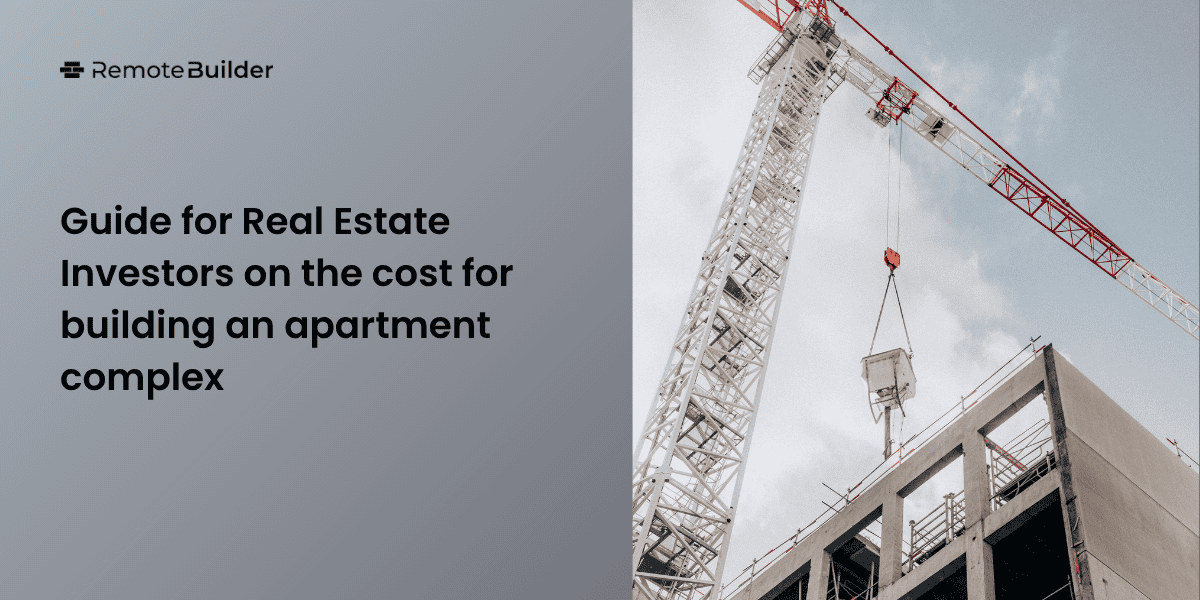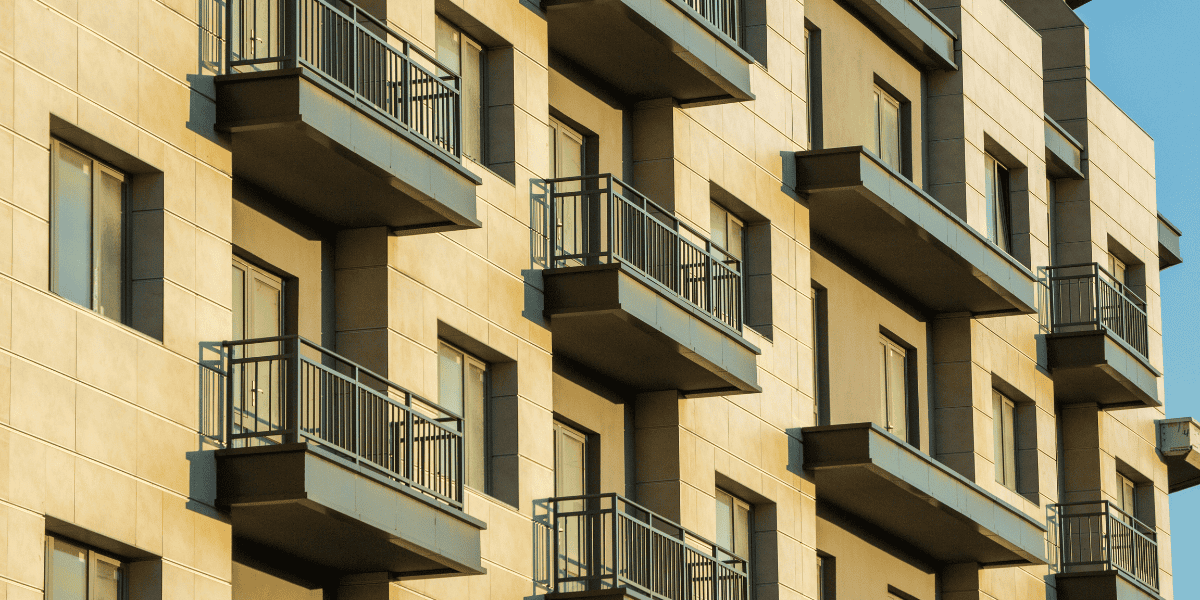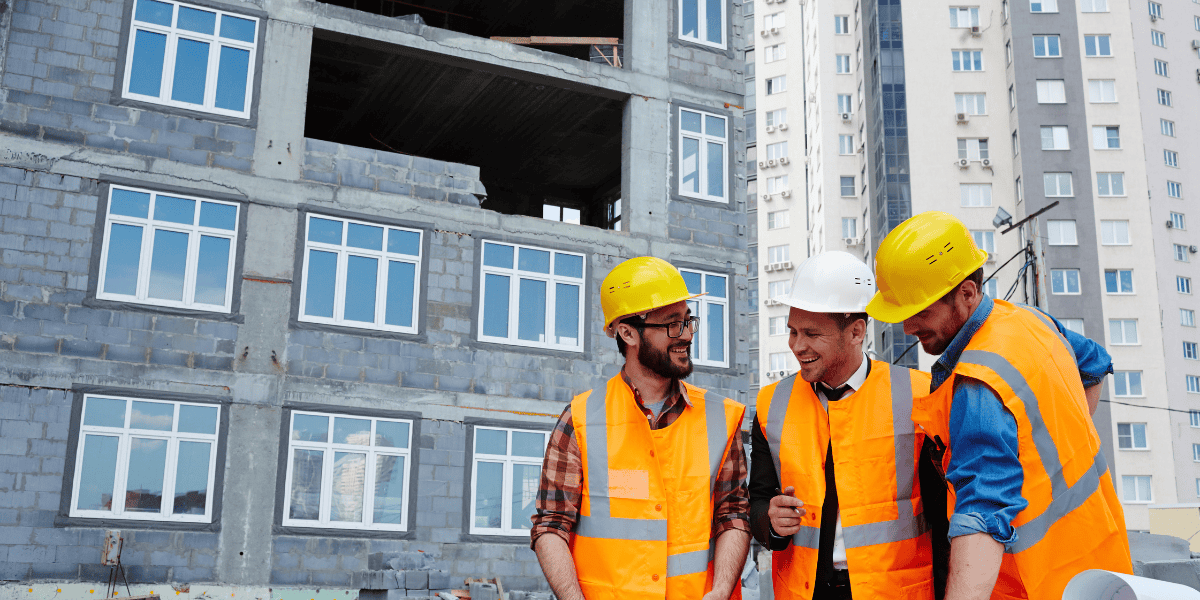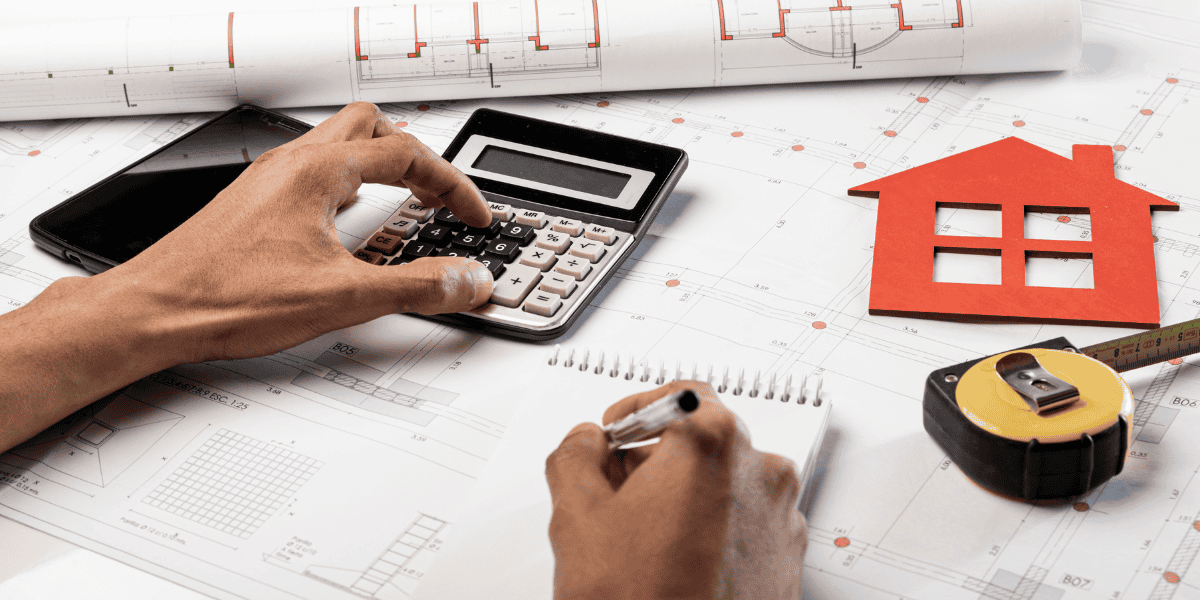Building an apartment complex is a major undertaking, but it’s also one of the most powerful ways to generate long-term income and equity. Whether you’re a first-time multifamily investor or a seasoned developer expanding your portfolio, one question drives every decision: how much to build an apartment complex.
Like most real estate questions, the answer depends on several variables: location, unit size, materials, design complexity, and the type of building (garden-style vs. mid-rise vs. high-rise). In this guide, we’ll break down:
- Average cost per unit and square foot
- Land acquisition, permits, and soft costs
- Construction materials and labor trends
- Factors that increase or reduce total cost
- Tips for remote or out-of-state investors
- Smart ways to manage risk and budget accurately
Today’s tenants expect more, modern renovations like open layouts, integrated smart tech, and wellness-focused amenities can justify higher rents and raise overall asset value.
Average cost to build an apartment complex
Before diving into the specifics, it’s helpful to understand the national averages that developers and investors typically use as benchmarks. Construction costs fluctuate annually and vary widely by building type, location, and market conditions.
As of 2025, here’s what you can expect in terms of average per-unit and per-square-foot costs:
| Type of Building | Cost per Unit | Cost per Sq Ft |
| Low-rise (1–3 stories) | $150,000–$225,000 | $150–$220 |
| Mid-rise (4–7 stories) | $225,000–$350,000 | $200–$300 |
| High-rise (8+ stories) | $300,000–$550,000+ | $275–$400+ |
Source: National Multifamily Housing Council (NMHC), RSMeans Data, and Dodge Data & Analytics
These estimates reflect construction-only costs and don’t include soft costs, land acquisition, or developer fees. It’s critical to tailor your budgeting model based on your project’s location, building design, and amenity scope.
Key variables include:
- Urban vs. suburban land costs
- Local construction labor rates
- Materials like steel vs. wood framing
- Amenities (parking garages, elevators, gyms, etc.)
The 2024 NMHC State of Multifamily Risk Report highlights top concerns for developers, including construction delays, material pricing volatility, and regulatory barriers.
Cost breakdown, what’s included in the total
To accurately budget for an apartment complex, you need more than just a ballpark figure, you need a clear understanding of what those costs represent. Apartment construction involves a wide range of expenses that go well beyond bricks and mortar.
From land acquisition and legal fees to vertical construction and interior finishes, each cost category plays a critical role in your project’s total budget. Below, we break down the five major cost categories that every real estate developer should plan for in 2025.
1. Hard costs (55%–70% of total budget)
These are the direct costs associated with the physical construction of the building.
- Site Work: Land clearing, grading, excavation, utility installation
- Foundation: Concrete, footings, basement construction
- Framing: Structural wood or steel, load-bearing components
- Exterior: Roofing, siding, windows, doors
- Interior Construction: Drywall, flooring, painting, tiling
- MEP Systems: Mechanical, electrical, plumbing infrastructure
- Elevators & Accessibility: Required for mid/high-rise buildings
- Landscaping: Fencing, sidewalks, green spaces, lighting
2. Soft costs (20%–30%)
Soft costs cover non-physical expenses tied to design, administration, compliance, and financing.
- Architectural and engineering fees: Design blueprints, structural calculations, HVAC and electrical layouts
- Permits and approvals: Building permits, environmental reviews, impact fees
- Legal and administrative fees: Contracts, zoning hearings, insurance
- Project management: Developer fees, third-party oversight, site supervisors
- Marketing and lease-up costs: Branding, pre-leasing, advertising materials
- Financing costs: Loan origination fees, interest reserves, lender inspections
3. Contingency and reserves (5%–10%)
These are funds set aside to manage unexpected costs and ensure financial flexibility.
- Construction contingency: Covers change orders, supply delays, labor shortages
- Developer reserve: Additional buffer for unplanned administrative or holding costs
- Operating reserve: Post-construction cash cushion to cover initial months of operation
Optional add-ons (Project Dependent)
- Sustainability upgrades: Solar panels, green roofs, energy-efficient systems
- Amenities: Pools, gyms, co-working spaces, smart tech packages
- Security systems: Surveillance, access control, secure parking
- Furnishings (for turnkey units): Appliances, furniture, decor
Understanding these components allows developers to forecast expenses more accurately and mitigate the risk of budget overruns. A well-structured budget not only ensures smoother execution but also strengthens financing proposals when presenting to lenders or investors.
Regional cost differences across the U.S.
Construction costs vary significantly based on geographic location, due to land value, local building codes, and labor market conditions.
| Region | Cost per Sq Ft (Range) | Notable Factors |
| Northeast (e.g., NYC, Boston) | $300–$450+ | High labor costs, strict zoning |
| West Coast (e.g., LA, SF) | $275–$425 | Earthquake codes, expensive permits |
| South (e.g., Texas, Florida) | $180–$300 | Lower labor/material costs |
| Midwest (e.g., Ohio, Illinois) | $150–$250 | Affordable land, slower permit times |
How long does it take to build an apartment complex?
The answer depends on several factors, including building type, location, permitting requirements, and project scale. Understanding the typical timelines for different types of multifamily developments, can help you plan better, secure financing, and set realistic expectations for lease-up and return on investment.
In this section, we break down average construction timelines and explain the key variables that can accelerate, or delay, your project.
Pre-construction phase: 6–12 months (due diligence, design, permits)
Construction phase:
- Garden-style: 10–14 months
- Mid-rise: 14–20 months
- High-rise: 20–30+ months
- Post-construction: 2–4 months for inspections, leasing, and occupancy
Pro Tip: Delays in permitting or supply chain disruptions can add months to your timeline—include buffers in your schedule.
Common cost drivers and how to control them
Even the most well-planned apartment complex projects can experience cost overruns if key cost drivers are not managed proactively. These are the elements that most frequently lead to budget inflation, and controlling them can be the difference between a profitable investment and a money pit.
Below are the five most common cost drivers in apartment construction and practical strategies developers and investors can use to keep them under control:
1. Material price volatility
The cost of construction materials, especially lumber, steel, copper, concrete, and drywall can fluctuate dramatically due to global supply chain disruptions, inflation, tariffs, and local shortages. The Producer Price Index (PPI) is a valuable tool for tracking input cost inflation for materials like steel, lumber, and copper that affect apartment construction budgets.
How to control it:
- Lock in prices early: Negotiate bulk purchase agreements with suppliers or general contractors to fix prices in advance, especially for long lead-time materials.
- Source locally when possible: Local sourcing reduces transportation costs and minimizes supply delays.
- Use alternatives: If steel prices surge, consider engineered wood or hybrid framing where code permits.
According to Gordian’s 2025 industry report, construction costs across equipment, labor, and materials have shown modest increases heading into the year.
2. Labor availability and wage fluctuations
Labor is one of the largest components of hard costs. Shortages of skilled workers, especially in booming real estate markets, can drive up hourly wages, increase delays, and reduce productivity. How to control it:
- Vet subcontractors thoroughly: Ensure they have adequate staffing, reliable performance history, and proper licenses.
- Use modular or prefabricated construction: Reduces reliance on on-site labor and accelerates the build schedule.
- Incentivize retention: For longer projects, offering bonuses for timely completion or performance benchmarks can help secure and retain skilled workers.
Labor costs vary widely across the U.S., and the Bureau of Labor Statistics’ wage database offers up-to-date information on regional construction wages by role.
3. Change orders and design scope creep
Unplanned changes in materials, finishes, layouts, or code compliance during construction can derail budgets. Each change order requires renegotiation, often at premium cost and with project delays. How to control it:
- Finalize all design decisions before breaking ground. Avoid “designing on the fly.”
- Conduct thorough pre-construction meetings with architects, engineers, and contractors to identify potential issues.
- Build in a contingency buffer (5%–10%) for minor scope changes without disrupting cash flow.
4. Delays in permits or inspections
City or county approval processes can stall your project for weeks or months, especially in high-density urban areas. Each day of delay increases holding costs—such as interest, property taxes, and insurance. How to control it:
- Engage a local permitting consultant or expeditor who understands the municipal process and has established relationships.
- Start early, apply for zoning clearances, permits, and utility hookups as soon as preliminary designs are ready.
- Maintain proactive communication with city officials and request updates on timelines and inspection criteria.
5. Poor project management and communication
Miscommunication between developers, architects, GCs, and subcontractors often leads to misalignment, errors, duplication of work, and time loss. How to control it:
- Use project management software, tools like Procore, Buildertrend, or Monday.com centralize documentation, task tracking, and team updates.
- Appoint a dedicated project manager or owner’s rep who can enforce accountability and serve as a single point of contact.
- Hold regular check-ins (weekly or bi-weekly) with detailed progress reviews and budget health checks.
By recognizing these cost drivers and establishing controls from the start, you significantly reduce the risk of cost overruns and ensure your apartment project stays on track, both financially and operationally.
Cost control tips
Controlling costs during the construction of an apartment complex isn’t just about saving money, it’s about protecting ROI, securing financing, and maintaining project momentum. Below are actionable strategies real estate developers and investors can implement across the project lifecycle to manage expenses without sacrificing quality.
1. Conduct a detailed feasibility study upfront
A strong feasibility study acts as the foundation of your financial model. It helps determine whether the project aligns with local demand, zoning restrictions, and realistic build costs. How to do it:
- Analyze comps, cap rates, and rental trends.
- Assess entitlement risks and land conditions.
- Include conservative assumptions for build time, occupancy, and exit valuation.
2. Choose the right project delivery method
The delivery method (Design-Bid-Build vs. Design-Build vs. Construction Manager at Risk) impacts timeline, cost transparency, and accountability.
Tip: Consider Design-Build for tighter coordination and fewer change orders. Or, use CM-at-Risk for projects with complex permitting or multiple phases.
3. Invest in pre-construction planning
Many cost overruns stem from poor planning, unclear scope, and late-stage design changes. How to do it:
- Finalize architectural, structural, and MEP designs before ground breaks.
- Conduct constructability reviews and value engineering sessions.
- Use BIM (Building Information Modeling) to identify conflicts before they occur.
4. Lock in key trade contracts early
Labor and materials markets fluctuate. Locking in subcontractors and suppliers in advance reduces the risk of future cost escalations. How to do it:
- Identify long-lead trades early (e.g., HVAC, elevators, windows).
- Negotiate guaranteed maximum price (GMP) contracts where feasible.
- Bundle trades where it creates efficiencies (e.g., electrical + low-voltage systems).
5. Set a realistic contingency and use it strategically
Every project faces surprises. A smart contingency plan provides flexibility without jeopardizing returns. How to do it:
- Allocate 5%–10% of total project costs as contingency.
- Monitor usage and document all draws against it.
- Don’t tap into contingency for predictable upgrades or vanity items.
6. Monitor cash flow with real-time budget tracking
Delayed cost reporting leads to delayed decisions. Modern tools offer better visibility. How to do it:
- Use construction accounting software (e.g., Procore, Buildertrend, or CoConstruct).
- Break down budgets by CSI Division (e.g., Division 3 for concrete, Division 9 for finishes).
- Require monthly budget-to-actual reporting from your GC.
7. Phase your project (when feasible)
Large multifamily projects can benefit from phasing, especially in tight capital markets or uncertain rental demand environments. How to do it:
- Build in 2–3 stages if land and design allow.
- Lease and generate cash flow from Phase 1 before starting Phase 2.
- Spread out capital requirements and mitigate risk.
8. Optimize for operational efficiency from the start
Designing for lower operating expenses (OpEx) boosts long-term NOI and asset value. How to do it:
- Install energy-efficient systems (HVAC, insulation, lighting).
- Choose durable, low-maintenance materials (e.g., LVT flooring, quartz countertops).
- Centralize HVAC or laundry systems where appropriate.
Strategic design choices and material upgrades can significantly boost returns, learn how to increase your property’s value without overcapitalizing.
9. Build relationships with local officials
Delays in inspections, approvals, or utility hook-ups can cost thousands per week. How to do it:
- Introduce yourself early to planning/zoning staff and inspectors.
- Understand review cycles and staffing limitations.
- Hire a local expeditor if you’re investing remotely.
10. Always have a plan B (and C)
Backup plans reduce panic when timelines or suppliers fall through. How to do it:
- Maintain a second-tier list of subcontractors and vendors.
- Know alternate financing or refinancing options if costs spike.
- Be prepared to modify unit mix or design based on demand signals.
Construction is complex, but budgeting doesn’t have to be chaos. With detailed planning, early procurement, ongoing oversight, and strong local relationships, you can build multifamily properties that stay on budget, deliver on time, and perform as expected.
Staying organized throughout the build requires proactive oversight, this construction project management checklist can help keep your team aligned and your timeline on track.
Key factors that affect total construction cost
Even after estimating hard, soft, and contingency costs, the final construction budget for an apartment complex can still vary significantly. This is because a number of external and project-specific factors play a substantial role in shaping the total expense. Understanding these variables can help developers optimize decisions early in the planning phase and avoid expensive surprises later.
1. Location and land costs
- Urban vs. suburban: In high-demand urban cores, land is significantly more expensive and may require demolition of existing structures, hazardous material removal, or complex zoning approvals. Conversely, suburban or secondary markets may offer more affordable land but might lack infrastructure or municipal support, increasing development costs.
- Site conditions: Sloped terrain, flood zones, poor soil quality, or remote access can lead to costlier site prep and foundation work.
- Impact fees and local taxes: Some cities impose high development impact fees or transfer taxes, which can materially affect your soft cost estimates.
2. Building type and design complexity
- A low-rise garden-style complex is typically cheaper to build due to its simplicity and wood-frame construction.
- Mid-rise and high-rise buildings often require concrete and steel framing, elevators, fireproofing, more complex MEP systems, and are subject to stricter building codes.
- Incorporating modern amenities like gyms, rooftop decks, or underground parking can significantly increase both material and labor costs, especially if they require structural modifications or specialized contractors.
3. Labor and material pricing trends
- The cost of skilled labor varies greatly by region, driven by local demand, union presence, and the availability of tradespeople.
- Materials like steel, copper, lumber, and concrete are subject to market fluctuations, tariffs, and supply chain disruptions. For instance, a 10–15% swing in steel prices can materially alter your framing and structural budget.
- Prefabrication and modular construction can help reduce labor costs and project timelines in some markets but may increase transport and assembly requirements.
4. Permitting, approvals, and legal hurdles
- Local jurisdictions may require zoning variances, design reviews, environmental impact studies, and community hearings—especially for large or high-density projects.
- Permit timelines can vary from a few months to over a year in complex urban environments.
- Delays at this stage can lead to increased holding costs (interest, property taxes, insurance) and missed market timing, especially if rental demand is seasonal.
5. Timeline and project Phasing
- The longer the project timeline, the more likely it is that material prices or interest rates may change mid-project.
- Phased construction (building in stages) can allow for earlier occupancy and cash flow but may increase logistical complexity and mobilization costs for contractors.
By accounting for these influencing factors early on—through feasibility studies, site evaluations, and discussions with local consultants—you can make smarter investment decisions and reduce risk during development.
Cost per unit examples
Understanding cost per unit is one of the clearest ways to benchmark a multifamily development. While every project is unique, analyzing real-world examples helps investors and developers visualize capital requirements and returns. Below are three representative case studies across different property types and geographies:
12-Unit Garden-Style Complex – Central Florida
It typically comes in at around $2.4 million in total development cost. This translates to roughly $200,000 per unit or $180 per square foot. These buildings usually follow a 1–2 story layout and utilize wood-frame construction, making them more cost-effective and faster to build.
With surface parking, no elevators, and modest shared amenities, they are well-suited for suburban settings where site preparation costs are relatively low due to ample land availability and fewer regulatory hurdles.
50-unit mid-rise apartment building in Austin, Texas
It averages about $12 million in total cost, which equates to $240,000 per unit or $220 per square foot. These projects typically feature a five-story stick-over-podium design, complete with elevators and structured parking. Common amenities such as a fitness room or rooftop deck further add to the complexity.
Additionally, higher soft costs, including architectural design, permitting, and consultant fees, drive up the overall investment, reflecting the tighter urban constraints and competitive housing demand in Austin.
100+ unit urban high-rise in downtown Los Angeles
It can cost anywhere between $35 million and $45 million, with per-unit costs ranging from $350,000 to $450,000+ and construction costs between $350 and $450+ per square foot. These projects are typically 12 or more stories and require concrete and steel construction to meet urban zoning and safety requirements. Located in a dense metro area, they often involve complex logistics, stricter building codes, and elevated labor and material costs, all of which significantly impact the development timeline and budget.
How long does it take to build
Time is money—especially in real estate development. From land acquisition to certificate of occupancy, the timeline for building an apartment complex varies based on the project’s size, location, and complexity.
Garden-style (10–14 months)
Smaller projects like a 10–20 unit garden-style apartment, typically move the fastest. They require less site work, use simpler construction methods (e.g., wood frame), and can often be completed in 10 to 14 months, assuming permits and inspections go smoothly.
Mid-rise (14–20 months)
Mid-rise buildings (4–7 stories) are more complex due to zoning approvals, structural requirements, and mechanical systems. These projects generally take 14 to 20 months, especially if they include amenities like structured parking, elevators, and green building certifications.
High-rise (18–30 months)
Urban high-rises can take 18 to 30 months—or longer. These builds often require deep foundations, extensive permitting, union labor coordination, and phased construction. In dense cities like New York or San Francisco, staging and logistics can extend timelines further.
Why it matters: Longer builds = higher carrying costs. You’ll accrue interest on construction loans, property taxes, and insurance throughout.
Delayed timelines impact lease-up and ROI.
More time increases exposure to market shifts (e.g., rising interest rates, labor shortages, or policy changes). Working with an experienced general contractor, planning realistic milestones, and proactively managing approvals can reduce delays and keep your project timeline and budget—on track.
Tips for remote or out-of-state investors
Remote investing in multifamily real estate is becoming increasingly common, especially as technology allows developers to manage construction projects without being physically present. However, building from afar comes with its own set of risks, especially when dealing with complex apartment builds involving high capital outlay and long timelines.
Below are strategies that help remote or out-of-state investors stay on top of their project and budget:
1. Hire a local project coordinator or construction manager
A dedicated on-site representative can serve as your eyes and ears, providing real-time updates, coordinating with contractors, and resolving issues before they escalate. They can help manage progress against milestones, ensure quality control, and verify that change orders are legitimate and justified.
2. Use remote management platforms
Platforms like Procore, Buildertrend, or custom CRM dashboards allow you to monitor timelines, budgets, contractor communications, and documentation from anywhere in the world. For investors looking for remote renovation project management services, it’s critical to have a structured system that combines local boots-on-the-ground support with centralized oversight. And businesses like RemoteBuilder can streamline everything, from hiring vetted contractors to managing payments via escrow for added financial protection.
If you’re managing construction from afar, use this remote home renovation checklist to ensure you’re covering every critical milestone, from hiring to handover.
3. Leverage virtual site visits and progress reporting
Schedule regular video walkthroughs at key project milestones. Ensure photo documentation of every major phase—site work, framing, MEP, inspections, finishes. Ask contractors to upload weekly or biweekly progress reports with budget status updates.
4. Set up escrow-based payment systems
Avoid paying large sums upfront. Escrow services or milestone-based payments ensure that contractors are paid based on performance and verified deliverables. This structure protects against delays, disputes, or unfinished work, especially valuable for absentee investors.
5. Build a local network
Even if you’re investing remotely, having local real estate agents, lawyers, permitting consultants, and utility contacts can save weeks of coordination and reduce dependency on any single contractor. In case of delays or underperformance, your local team can help you source replacements and keep the project moving.
Bonus Tip: Always over-communicate and document everything. When you’re not on-site, clarity and transparency become your best insurance policy. A combination of strong local partnerships and centralized remote management tools will help protect your investment and ensure a smoother build, from breaking ground to handing over the keys.
Tax implications and incentives
Apartment complexes offer powerful tax advantages that can significantly improve your investment’s net returns. The IRS allows residential rental properties to be depreciated over 27.5 years, as detailed in IRS Publication 527.
One of the most notable is depreciation, where residential rental properties can be depreciated over 27.5 years, allowing investors to reduce taxable income even as the property appreciates in value. Savvy developers also use cost segregation studies to accelerate depreciation by identifying shorter-lived assets (like appliances, flooring, and HVAC) and writing them off over 5, 7, or 15 years instead of 27.5.
Additionally, many cities and states offer incentives for affordable housing, such as tax credits, grants, or density bonuses. Developers who incorporate green building features, such as energy-efficient systems, solar panels, or LEED certification, may qualify for federal or local tax credits or rebates.
Developers aiming for high-performance, eco-friendly buildings can pursue LEED certification to qualify for additional tax credits and boost long-term NOI.
These incentives can offset construction costs, enhance cash flow, and make your multifamily investment more financially resilient over time. Always consult a tax advisor to structure your project for maximum benefit.
While apartment complexes offer depreciation benefits, it’s important to also understand what qualifies under IRS rules—especially when asking are home renovations tax-deductible in your case.
Final thoughts
Building an apartment complex is a high-stakes investment, but one with the potential for strong, long-term returns if planned strategically. To recap, your total development cost will be shaped by five major components: hard costs, soft costs, land acquisition, contingency reserves, and financing. Each plays a critical role in the overall budget.
It’s important to remember that costs vary dramatically depending on the type of building (garden-style vs. high-rise), regional labor and materials pricing, permit processes, and your design and amenity choices. That’s why early and accurate planning is non-negotiable.
Work closely with a licensed architect, a general contractor, and a financial advisor to build a realistic budget, control risks, and identify potential savings, especially if you’re managing the project remotely. Whether you’re building a multifamily property or selling one, having a strong foundation like this real estate agent business plan can guide your decisions toward long-term growth.
Considering building a complex remotely?
We specialize in end-to-end support for out-of-state and international investors. Let’s talk about how we can help you build smarter.
How much profit can you make from an apartment complex?
Profitability depends on location, unit count, rental rates, and operational efficiency. A well-managed apartment complex can yield 7%–15% annual cash-on-cash returns, with additional gains from long-term appreciation and tax benefits. High-demand markets with low vacancy rates tend to perform best.
Is it cheaper to buy or build an apartment complex?
Buying an existing complex is usually faster and may appear cheaper upfront, especially in saturated markets. However, building gives you full control over design, materials, and amenities—and often results in higher long-term ROI, especially in markets with limited inventory or rising property values.
Can you get a loan to build one?
Yes. Investors and developers typically use construction loans, which cover land acquisition and building costs. These loans often convert to permanent financing after completion. Be prepared with detailed project plans, cost estimates, and a strong financial profile to secure favorable terms.
How many units make an apartment complex profitable?
There’s no fixed number, but generally, 12–20 units can achieve break-even or moderate profits in lower-cost areas. In urban or high-cost markets, 50+ units may be necessary to cover overhead, financing, and management expenses while delivering healthy margins.
What’s the ROI timeline?
The return on investment (ROI) timeline typically ranges from 3 to 7 years, depending on build time, lease-up speed, and operational stability. For value-added strategies or ground-up builds, expect delayed but higher returns once full occupancy and rent stabilization are achieved.









